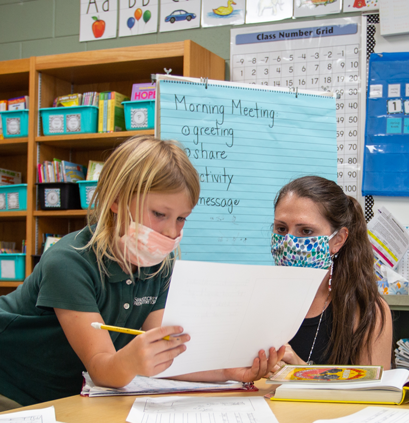

Assessing Children as Learners
Source/Author: Dr. Lisa Bianco, Head of Lower School
September 09, 2021
It is around this time of year - the second and third weeks of school - that Shorecrest teachers begin to conduct formal types of assessments for literacy (reading, writing and spelling) and math. The assessments are to help teachers learn more about each student -- not only their level, but what they know, how they learn, and what their needs are at this point in time.
Assessments primarily inform teachers' instruction and help them plan lessons for individuals and small and large groups. The data from assessments can also raise questions about learners. As we assess students, we note their strengths and the strategies they are using, as well as areas we need to support and provide instruction or remediation.
National grade level benchmarks and standards align with and guide our assessments. As educators we know what knowledge, skills and behaviors in a given grade students should have at the start of the school year. It is important to note that assessments are not tests. Tests, quizzes and exit slips are administered after direct instruction has occurred.
This year we are also using an assessment tool that is not new, but new to the Lower School, called DIBELS (Dynamic Indicators of Basic Early Literacy Skills). The assessment tool provides “a set of procedures and measures for assessing the acquisition of literacy skills. They are designed to be short (one minute) fluency measures that can be used to regularly detect risk and monitor the development of early literacy and early reading skills in kindergarten through eighth grade.”
Assessments primarily inform teachers' instruction and help them plan lessons for individuals and small and large groups. The data from assessments can also raise questions about learners. As we assess students, we note their strengths and the strategies they are using, as well as areas we need to support and provide instruction or remediation.
National grade level benchmarks and standards align with and guide our assessments. As educators we know what knowledge, skills and behaviors in a given grade students should have at the start of the school year. It is important to note that assessments are not tests. Tests, quizzes and exit slips are administered after direct instruction has occurred.
This year we are also using an assessment tool that is not new, but new to the Lower School, called DIBELS (Dynamic Indicators of Basic Early Literacy Skills). The assessment tool provides “a set of procedures and measures for assessing the acquisition of literacy skills. They are designed to be short (one minute) fluency measures that can be used to regularly detect risk and monitor the development of early literacy and early reading skills in kindergarten through eighth grade.”
























